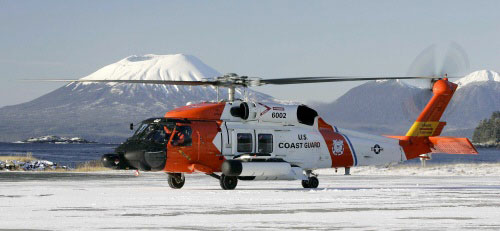HH-60J helicopter on the ramp at Sitka. Mount Edgecomb is in the background. This is a dormant volcano that looks identical to Japan’s Mount Fuji
In 1977 the Coast Guard air station serving Southeast Alaska moved from Annette to Sitka which is more centrally located in the area of responsibility. Coast Guard Air Station Sitka is located on 165 acres of property owned by the Coast Guard. The physical plant consists of a hangar complex, a barracks/ medical facility, a NAFA building, and fifteen family housing quadruplexes. The facilities are located immediately adjacent to the Sitka Municipal Airport and near the Mt. Edgecombe USPHS Hospital. Coast Guard floating units also tie up to a Coast Guard dock located on Japonski Island.
In March of 1977, the barracks and hangar were completed and the move of personnel and equipment began. On April 19 flight operations for three HH-3F Sikorsky helicopters were shifted to Sitka. On Alaska Day, October 17, 1977 CGAS Sitka was officially commissioned. The area of operations includes all of Southeast Alaska from Dixon Entrance to Cordova. It is bordered on the north, south, and east by the US/Canadian border and shares its western boundary in the central Gulf of Alaska with CGAS Kodiak. This area of responsibility includes 12,000 miles of coast line and all inland areas. Rugged coast, mountainous terrain, severe weather and vast distances between fuel caches and landing sites characterize this isolated region.
Flying in this challenging environment Sitka Crews average over 150 search and rescue cases a year, many completed in storm force winds, snow, low visibility and periods of extended darkness. Air Station Sitka’s aircrews had saved over 2300 lives, assisted thousands of others, and saved several hundred million dollars in vessel property from the perils of the sea. About half of the unit’s SAR cases involve conducting air ambulance missions from small villages, logging camps, boats and cruise ships The Air Station utilizes three HH-60J Jayhawk helicopters and has a complement of 21 officers and 120 enlisted personnel.
In a “ready” status 24 hours a day for search and rescue, the crew and helicopters are also used to support 75 marine aids-to-navigation, fisheries law enforcement, enforcement of laws and treaties, and various other missions in cooperation with federal, state, and local government agencies.
CGAS Sitka also participates in the maritime portion of Operation NORTHERN EDGE. This is an annual joint training exercise designed to practice operations, techniques, procedures and enhance inter-service operational capabilities. The Commander Coast Guard District 17 is dual-hatted and is also Commander Naval forces Alaska. The Harbor Defense segment of Northern Edge tests US Naval Forces Alaska unit’s ability to deploy, secure, and defend a port for use by US Forces.
There have been several noteworthy operations in recent years. In 1980 one of the most successful air-sea rescues in modern history occurred when the Dutch cruise ship Prinsendam caught fire 195 miles west of Sitka. Sitka crews were part of a joint international rescue team with units from the
U.S. Coast Guard, U.S. Air Force, Canadian forces and commercial resources. In all, 13 aircraft,
three Coast Guard cutters, and three commercial ships rescued the 522 passengers and crew within a 24-hour period without loss of life or serious injury. Sitka crews have also won national acclaim for several daring, lifesaving missions such as in the sinking of the fishing vessels Le-Conte (1998) and Becca Dawn (1999) during horrendous winter storms in the Gulf of Alaska. Aircrews battled 70-foot waves, severe turbulence, and darkness to save fishermen from the frigid waters. The professionalism, ingenuity, and unwavering devotion to duty displayed by the men and women of the Coast Guard continue to reflect great credit upon themselves, their unit, and the United States Coast Guard.


